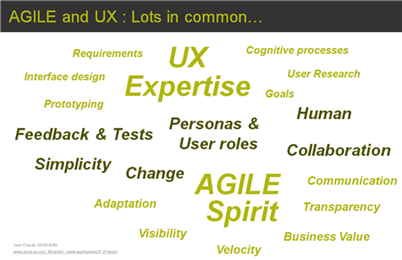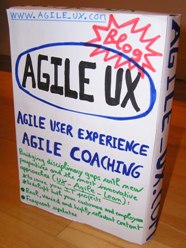Posted by jc-Qualitystreet on 2010/10/17
The state of Agile User Experience Survey (by Anders Ramsay) is now online:
Take the survey !
Quick and easy. It is time for UX practitioners to get a better undertsanding of our UX activities on Agile projects !
Results will be posted at after about a week.
Posted by jc-Qualitystreet on 2009/11/21
and incredible leverages for an effective collaboration !
- Feedback and tests (the most interesting thing)
- Human first (essence of UX and UCD but also the first value of Agile Manifesto !)
- Personas and user roles
- Collaboration
- Simplicity
- Change
Shared values and principles : an illustration :

AgileUx:so close. JC Grosjean
Posted by jc-Qualitystreet on 2009/01/18
12 best practices compiled by Jeff Patton that have proven their efficiency with multiple teams.
Here is the list of the emerging practices with a quick review.
1 Drive: UX practitioners are part of the customer or product owner team
MUST User Experience activities support analysis and prioritization tasks carried out by of the Product Owner (scrum) / Client (XP). This can go up to write User Stories and even play the Product Owner role. This position does not harm our cooperation with the development team. In one of my recent projects, we had a Product Owner Team (speaking one voice) working with the UX consultant to facilitate understanding and putting User Stories into context.It was very efficient.
2 Research, model, and design up front – but only just enough
MUST Sprint 0 offers us a good opportunity to do our job, but timeframe is diiferent … UX must go straight to the point: personas, quick modeling…Sprint are short (2, 3 or 4 weeks) and people expect expertise from us.
3 Chunk your design work
MUST No choice but not an easy thing. During the first iteration, it is a real difficulty.
4 Use parallel track development to work ahead, and follow behind
MUST It is a real challenge but it is also the most exciting part of the job in an Agile context. During a specific iteration (n), UX practionners have to:
- design the content of next iterations (n+1, n+2)
- collaborate with developers on the current iteration
- evaluate results of the previous iteration (n-1)
5 Buy design time with complex engineering stories
CAN Very contextual.
6 Cultivate a user validation group for use for continuous user validation
CAN It helps and it is great if the pool of users is the target (but the pool must be large enough). It could be also a way to initiate change…
7 Schedule continuous user research in a separate track from development
CAN A question of time and resources but impossible if there is only one UX guy in the organization…
8 Leverage user time for multiple activites
SHOULD OK, but do not forget that visiting users for nterviews, questionnaires, card sorting, screen reviews requires time for preparation, analysis and restitution…
9 Use RITE to iterate UI before development
MUST Feedback and adaptation are the keys. Teams do not want to wait; they don’t care about a formal and standard usability testing reports.
10 Prototype in low fidelity
MUST Paper, PPT, Visio, whiteboard … everything is OK if you give value to the team and the project.
11 Treat prototype as specification
MUST Always ! High level Storyboard + User Stories + Wireframes : a magic potion
12 Become a design facilitator
MUST It is my conviction : facilitation is the future of our profession !
Posted by jc-Qualitystreet on 2009/01/07
Once again Jakob Nielsen, one of the most famous Usability evangeslist is doing a good job. His alertbox, Agile Development Projects and Usability, is short, well written, and the report itself well documented.
Agile methods aim to overcome usability barriers in traditional development, but pose new threats to user experience quality. By modifying Agile approaches, however, many companies have realized the benefits without the pain.
A good summary, but I regret Jakob doesn’t insist enough on new challenges, constraints and adjustments that Interaction designers and usability specialists must do to efficiently work in such a context.
Finally, his conclusion is pretty fair: Agile methods and usability can perfectly work together to enhance product or service quality and the overall user experience.


